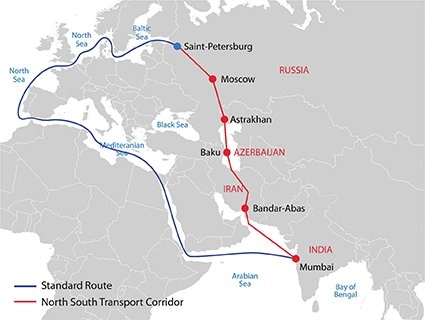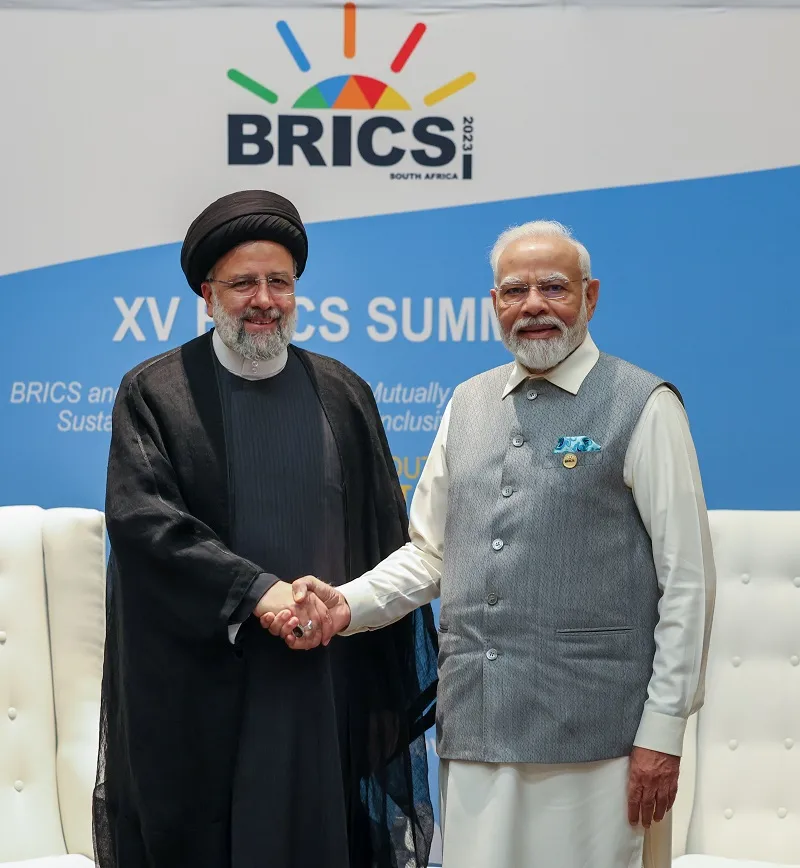India and Iran on Thursday agreed upon fast-tracking infrastructure cooperation, focusing especially on Chabahar project and the International North-South Transport Corridor (INSTC).
The bilateral meeting between Prime Minister Narendra Modi and Iranian President Seyyed Ebrahim Raisi in Johannesburg on the sidelines of the BRICS Summit on Thursday laid special emphasis on strengthening bilateral cooperation in various fields including trade and investment, connectivity, energy and counter-terrorism.
PM Modi congratulated the Iranian leader on joining the BRICS family – Iran will become a full-member of the grouping starting January 2024 – while Raisi thanked Prime Minister for India’s support for backing its BRICS membership and also congratulated on the success of Chandrayaan mission.
In July, Iran – an observer state till now – also got a full membership of the Shanghai Cooperation Organisation (SCO) under the rotating chairmanship of India.
Acknowledging India’s growth as an emerging power, Tehran had urged New Delhi to accelerate the process of Iran’s admission to the powerful five-member BRICS grouping that includes Brazil, Russia, India, China, and South Africa.
Interestingly, just before their meeting in Johannesburg, Raisi dialled PM Modi last week discussing BRICS, the numerous cultural and civilisational commonalities that binds both nations and also realising the full potential of Chabahar Port as a connectivity hub.
Iranian Foreign Minister Hossein Amirabdollahian then held talks over phone with External Affairs Minister S Jaishankar just before the BRICS Summit in South Africa.
In Johannesburg on Thursday, the Iranian President told PM Modi that both countries have “good capacities and grounds” for expanding cooperation in the fields of science, technology, space, energy and transit.
He also mentioned that strengthening cooperation in the field of North-South Corridor can be vital to the interests of both nations.
The two leaders reviewed bilateral ties including in areas of trade & investment, energy, connectivity, and counter-terrorism. They agreed to fast track infrastructure cooperation, including Chabahar project. They also exchanged views on regional developments, including… pic.twitter.com/0Aj0TeT2W5
— Arindam Bagchi (@MEAIndia) August 24, 2023
India has maintained that if the full potential of the strategic Chabahar port – being built with India’s help in Iran – is realised, then it can not only become the gateway for Indian trade with Europe, Russia and Commonwealth of Independent States (CIS) countries but also turn into one of the most important ports in the world in the near future.
New Delhi has been spotlighting the importance of strengthening the transport and logistics architecture of the Eurasian region via the INSTC and its linking to Chabahar.

The large-scale 7,200 km-long North-South multimodal trade corridor, which will start from Mumbai with nodes in West Asia, Central Asia, Caucasia and Russia, would eventually link the far-west Russian city of Saint Petersburg to the ports of Iran and India.
As India continues to ship humanitarian assistance for the people of Afghanistan through the Shahid Behesti Terminal at the Chabahar Port, the two leaders on Thursday also exchanged views on the situation in the Taliban-ruled country.
For the first half of this year, 16 million people in #Afghanistan received life-saving food from WFP.
We are grateful for generous donors like #India who make that happen.
@MEAIndia@Dpa_mea pic.twitter.com/zwsdiaY8UL
— WFP Afghanistan (@WFP_Afghanistan) August 15, 2023
“Had a wonderful meeting with President Ebrahim Raisi. I am glad that Iran will be joining BRICS. Discussed ways to deepen trade and cultural cooperation between India and Iran,” tweeted PM Modi after the meeting with Raisi.
Also Read: Russia promises to remove all hurdles choking new route linking Saint Petersburg with Mumbai




















